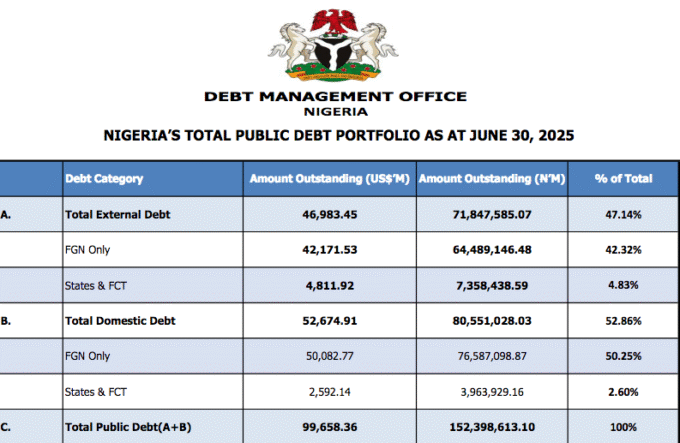…Experts assess gains, risks, sustainability
By Chukwuma Umeorah
With market capitalisation surging nearly 50 per cent in just eight months and foreign inflows tripling year-on-year, Nigeria’s capital market is enjoying one of its strongest rallies in its history. The Nigerian Exchange (NGX) has also witnessed turnover exceeding N4.19 trillion in just six months, way higher than volumes seen at the historical peak years of 2007 and 2008. The All Share Index has also surged to record highs, propelled by reforms in the foreign exchange market, bank recapitalisation, and a newly signed insurance law that has drawn fresh activity into the sector.
While the numbers point to renewed investor confidence, the speed of the rally has raised important questions. Analysts warn that unless the broader economy delivers stronger productivity in manufacturing, agriculture and industrial output, the market’s current momentum may prove difficult to sustain. The risk, they say, is that short-term policy gains may not translate into long-term value if underlying growth drivers remained weak.
The Managing Director /CEO APT Securities, Kasimu Garba Kurfi noted that the rally currently being witnessed in 2025 reflected deeper changes in the structure of the market and cannot simply be dismissed as another cycle of speculation.
Kurfi pointed out that the All Share Index had already gained 16 per cent by June, but added that in the six weeks that followed, the index accelerated by another 26 per cent, closing above 42 per cent year-to-date. According to him, this performance showed that the narrative of a fragile or collapsing market no longer holds. “Those who believe the market is set to crash are simply out of touch with today’s reality,” he said, stressing that stability in the foreign exchange market, improved liquidity, and recent reforms have shifted the dynamics.
Reform-driven growth
Kurfi who spoke at the Mid-Year 2025 Capital Market Review and Outlook organised by the Capital Market Correspondents Association of Nigeria (CAMCAN) in Lagos, linked much of the optimism in the market to reforms. Kurfi highlighted the impact of the newly signed insurance law, which immediately triggered a surge across listed insurers, most of which gained between 30-50 per cent in less than a month. Similarly, the recapitalisation exercise in the banking sector had returned banks to the frontlines of market leadership. Several lenders, including GTBank, Access Bank, and Zenith Bank, have already raised over N2 trillion from the primary market.
In addition, the unification of the exchange rate had removed the arbitrage that previously fuelled distortions in the financial system. This, Kurfi explained, had restored investor confidence and drawn significant inflows. From January to July, foreign portfolio investors accounted for N1.14 trillion, representing about 27 per cent of the market, up from less than 8 per cent in 2022. Domestic investors, however, remained the dominant force, controlling about 73 per cent of total transactions, a factor Kurfi believes had made the market more resilient to global shocks.
Gains outpace real economy
Despite these achievements, questions remain on whether market growth is outpacing the real economy. Nigeria’s GDP grew by 3.7 per cent in the first half of the year. But much of that growth was concentrated in financial services rather than in agriculture, manufacturing, or industry. Critics argue that a reliance on financial market activity without corresponding expansion in job-creating sectors risks creating a disconnect.
“An economy survives on production, not on importation,” Kurfi cautioned. He recalled the 1980s, when Nigeria’s local industries produced textiles, vehicles, and other goods, a period when the naira was stronger than the dollar. “Today, if productivity in the real sectors does not match the pace of the market, the risk is that we are building wealth without a solid base,” he warned.
This concern is further underscored by the persistence of structural challenges. Inflation, though easing from 36 per cent last year to around 22 per cent, continues to squeeze households. Energy shortages and high operating costs weigh heavily on manufacturers. While reforms have stabilised key indicators, the absence of broad-based productivity raises doubts about whether today’s rally can translate into long-term economic stability. Analysts argue that the equity rally may be more a reflection of speculative inflows than genuine improvements in output and productivity
Mirage or reality
The sharp rise in certain stocks have revived debate about the possibility of a market bubble. In particular, some penny stocks and low-priced insurance stocks have gained by as much as 400 per cent in less than eight months, often without earnings to justify such valuations. Analysts warn that while the market overall was trading at price-to-earnings ratios well below global averages, pockets of overvaluation exist that could lead to painful corrections.
“This kind of rise in companies with little or no history of profitability should be treated with caution. Investors must separate momentum from fundamentals, because at some point, reality will catch up with prices.” He noted that some of these firms had not paid dividends in years, yet their share prices now trade at multiples far above their fundamentals.
Liquidity, concentration and investor behaviour
Another factor shaping the market is liquidity. Average daily turnover has risen from N5 billion last year to between N25 billion and N30 billion this year, driven by speculators moving away from foreign exchange and money markets into equities. This influx has created opportunities but also introduced new risks. It has concentrated power in a handful of companies. According to data, 20 firms now control 81 per cent of the market’s capitalisation, making the index heavily dependent on the performance of these heavyweights.
As a result, movements in a handful of stocks such as BUA Cement, Nestlé, or Airtel often determine the direction of the overall market index. Kurfi warned that this structure made the market less reflective of broad investor activity and more vulnerable to swings in its heavyweights. He pointed out that while 16 insurance firms posted significant gains recently, the index still fell due to losses in larger companies.
Another concern is the behaviour of new entrants. Many investors, he observed, are rushing into equities without understanding company fundamentals, buying simply on momentum. This speculative pattern, he said, mirrors past cycles and may lead to harsh lessons when corrections occur.
Collapse imminent?
On whether the market was headed for a crash, Kurfi dismissed it.
He said: “The crash that many expect will not happen. The players have changed.”
He explained that with domestic investors now controlling nearly three-quarters of activity, the market is less exposed to sudden exits by foreign funds, a major factor in the 2008 crash.
He acknowledged that corrections were inevitable, pointing to recent declines in stocks like MTN, BUA Cement, and Lafarge. But he insisted that these adjustments were healthy and should not be mistaken for collapse. “When a stock is overpriced, the market will correct it. That is not a bubble bursting, it is the market working as it should,” he said.
Economy through capital market lens
The outlook remained broadly positive. With inflation trending downward, monetary policy rate expected to ease before year-end, and reforms continue to attract inflows. He predicted that the NGX could surpass N100 trillion in market capitalisation by December, provided current momentum were sustained. Yet he reiterated that reforms and market liquidity must be matched by real productivity in agriculture, manufacturing, and energy. “The capital market reflects the economy. If we do not strengthen production, the gains will remain limited to investors and will not translate into wider economic growth.”


















Leave a comment